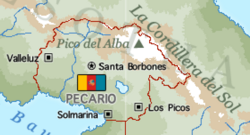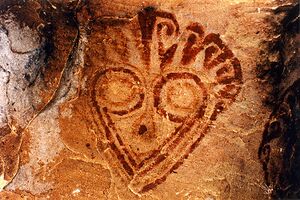Pecario
Republic of Pecario República de Pecario | |
|---|---|
Motto: "Unidos en la diversidad, juntos hacia el futuro." | |
 | |
| Capital | Santa Borbones |
| Largest | Valleluz |
| Official languages | Iverican, Quepec |
| Recognised national languages | Iverican, Quepec, Guaruma, other indigenous languages |
| Demonym(s) | Pecarian |
| Government | Unitary presidential republic |
• President | Andreas Linerea |
• Vice President | Gabriela Valdez |
• President of the Senate | Carlos Rojas |
| Legislature | Asamblea Legislativa Nacional |
| Independence from the First Iveric Republic | |
• Declared | 1742 |
| Area | |
• | 324,700 km2 (125,400 sq mi) |
| Population | |
• 2022 census | 22,658,480 |
| GDP (nominal) | 2022 estimate |
• Total | $200 billion |
• Per capita | $9,995 |
| Gini | 0.38 low |
| HDI | 0.800 very high |
| Currency | Pecarian pesos |
| Driving side | right |
| Calling code | +39 |
| Internet TLD | .pco |
This article is incomplete because it is pending further input from participants, or it is a work-in-progress by one author. Please comment on this article's talk page to share your input, comments and questions. Note: To contribute to this article, you may need to seek help from the author(s) of this page. |
Pecario, officially known as known officially in Iverican as La República de Pecario, concisely as The Republic of Pecario, and informally as Pecario, is a sovereign state in Alharu on Eurth. It is bordered on the South by Manamana. The seat of government is Santa Borbones, which contains the executive, legislative, and electoral branches of government,it is also the constitutional capital and the seat of the judiciary. The largest city and principal industrial center is Valleluz.
The sovereign state of Pecario is a constitutionally unitary state, divided into nine departments. Its geography varies from the peaks of the Cordillera del Sol in the North, to the eastern lowlands. A third of the country is in the mountain range. The country's population, estimated at 22 million, is multi-ethnic, including natives, mestizos and europans (mainly Ivericans). Iverican is the official and predominant language, although 36 indigenous languages also have official status, the most commonly spoken of which are quepec, aymaro and guaruma.
The history of Pecario begins with the dominance of the Tuachec empire in the 15th century, followed by the Iverican conquest in the 17th century. After uprisings, the country gained independence in 1753. The 19th century was marked by political instability, but also by progress in education and civil rights. In the 20th century, periods of military control alternated with democratic governments, seeking to combat corruption and inflation. In 2002, an unprecedented economic crisis struck, leading to the resignation of President Eduardo Chapo. Luis Mesa came to power in 2006, ushering in a calmer period until 2019. The Santa Polvo cartel emerged in 2010, taking control of the drug trade leading to a drug war. President Mesa will resign in 2019 after a scandal related to the Santa Polvo cartel, he will be replaced by Andreas Lineria. Today the country is one of the most corrupt state in the wurld, the government of Presidente Lineria is completely under the orders of the cartel and pretends not seeing the recurring massacres in the country. In 2020, the country was classified as a Narco-State due to the Pecarian government turning a blind eye towards drug cartels. Today, Pecario is plagued by corruption and violence related to drug trafficking.
Etymology
According to legend, centuries ago, before the formation of the country we know today as Pecario, the lands were inhabited by indigenous tribes. Among these tribes, there was a particularly respected and influential group that worshipped a sacred animal: the "pecario".
The pecario would be an emblematic animal of the region, a rare and mysterious creature, similar to a wild boar but with distinctive features. Its presence was considered a sign of fertility and prosperity for indigenous communities. The ancients considered the pecario as the guardian of forests, rivers and mountains, and they attached great spiritual importance to him. When the Iverican conquerors arrived in the area, they were intrigued by the stories of this sacred animal. They began naming the area after this legendary being, "Pecario," in homage to its deep cultural significance and importance to indigenous peoples.
Thus, the name "Pecario" would have become the symbol of the connection between the past and the present, a reminder of the cultural roots of this fictitious nation, rooted in respect for nature and the harmonious coexistence between man and the earth.
History
Prehistory and Tuachec period
The earliest evidences of human presence in Pecarian territory have been dated to approximately 12,000 BCE. Pecarian societies were based on agriculture, using techniques such as irrigation and terracing; camelid husbandry and fishing were also important.
The area now known as Pecario had been occupied for over 2,500 years when the Guaruma arrived. However, the present-day Guaruma are associated with the ancient civilization of the Guaruma Empire which had its capital at Vunawaku, in the east of the Pecario. The capital vity of Vunawaku dates from as early as 1500 BC when it was a small village based on agriculture. The Guaruma community grew to urban proportions between 700 AD and 900 AD, becoming an important regional power in Mesothalassa. As the rainfall decreased, the surplus of food decreased, and thus the amount available to underpin the power of the elites. Vunawaku disappeared around 1000 AD. The area remained uninhabited for centuries thereafter.They carved into rocks many petroglyphs throughout the country, notably those located in Guarpo.
Traces of Sjådska presence dating back to 320 BC on the banks of Manamana Bay attest to an active passage of this people. No physical structure has been discovered, but the discovery of an Útskip wreck near Marelia suggests that the Sjådska used the bay for trading and travel. It is likely that they traded and maintained good relations with the tribes present in the territory.
In the 14th century, the Tuachec emerged as a powerful state which, in the span of a century, formed the largest empire in Mesothalassa with their capital in Amauta. The Tuachec of Amauta originally represented one of the small and relatively minor ethnic groups, the Quepec. Gradually, as early as the thirteenth century, they began to expand and incorporate their neighbors. Tuachec expansion was slow until about the middle of the fifteenth century, when the pace of conquest began to accelerate, particularly under the rule of the emperor Huayna Cápac. Under his rule and that of his son, Yama Cápac, the Tuachec came to control most of the region of modern Pecario, with a population of 10 to 15 million inhabitants under their rule. Cápac also promulgated a comprehensive code of laws to govern his empire, while consolidating his absolute temporal and spiritual authority as the God of the Moon. The official language of the empire was Quepec, although hundreds of local languages and dialects were spoken. The Tuachec leadership encouraged the worship of Quilla, the moon god and imposed its sovereignty above other cults.The Tuachec considered their King, the Vagra Tuachec, to be the "child of the moon". We also owe them the Tuachec roads, a vast road network linking the regions of the empire to the capital city. It served as an economic and political integrative axis.
Conquest and colonial period
When Viracocha IV, the last Vagra Tuachec, became emperor in 1631, he inherited an empire weakened by a long famine and divided by quarrels of bellicose nobles. In October 1630, the stillian conquistador Diego de Montega landed with his men on the coast of Pecario. He is one of the migrants who are part of the Great Viatge fleeing the Iberic Empire. He quickly founded a first city named San Luis and then helped by rebellious Tuachec nobles he defeated and captured Emperor Viracocha IV at the Battle of Tawantinsuyo.
Geography
The geography of the country exhibits a great variety of terrain and climates. Pecario has a high level of biodiversity considered one of the greatest in the world, as well as several ecoregions with ecological sub-units such as the Meseta, dry valleys, and the Llanuras, which is a tropical savanna. These areas feature enormous variations in altitude, from an elevation of 8900 meters (106,800 ft) above sea level in Pico del Alba to nearly 70 meters (230 ft).
Pecario can be divided into three physiographic regions:
- The Cordillera region in the north spans 34% of the national territory. It contains some of the highest spots in all of Eurth such as the Pico del Alba, with an altitude of 8,900 meters (106,800 ft), and the Pico Nevado, at 8,750 meters (105,000 ft). Also in this region that are the Meseta and the Desierto de Sal de Sol, which is the largest salt flat in the world and an important source of lithium.
- The Sub-Cordillera region in the center and south of the country is an intermediate region between the Meseta and the Pampas (plain); this region comprises 17% of the territory of Pecario. It is distinguished by its farming activities and its temperate climate.
- The Pampas region in the south comprises 49% of the territory. It is located to the South of the Cordillera del Sol. It is a region of flat land and small plateaus, all covered by extensive dry forests containing enormous biodiversity.
Geology
The geology of Pecario includes a variety of different lithologies as well as tectonic and sedimentary environments. The country lies at the end of the Aurelia plate and borders caused by Tiauhain plate and the Paran plate. This can cause major earthquakes and Pecario has already suffered violent earthquakes during its history, the most recent being that of 2003 which killed more than 2000 people.
Climate
The climate of Pecario varies drastically from one eco-region to the other, from the tropics in the south to a polar climate in the north. The summers are warm, humid in the east and dry in the west, with rains that often modify temperatures, humidity, winds, atmospheric pressure and evaporation, yielding very different climates in different areas.Winters are very cold in the west, and it snows in the mountain ranges, while in the southern regions, windy days are more common.
Biodiversity
Pecario's variable altitudes, allow for a vast biologic diversity. Within this geographic area there are several natural parks and reserves such as the Parque Nacional del Sol Eterno, Reserva Costera del Coral, Parque Nacional de los Picos Nevados, and the Reserva del Desierto de Sal, among others.
Pecario boasts over 15,000 species of seed plants, including over 1,100 species of fern, 1,300 species of marchantiophyta and moss, and at least 700 species of fungus. In addition, there are more than 2,500 species of medicinal plants. Pecariois considered the place of origin for such species as peppers and chili peppers, peanuts, the common beans, yucca, and several species of palm. Pecario also naturally produces over 3,000 kinds of potatoes.
Pecario has more than 2,700 animal species, including 380 mammals, over 1,100 birds , 196 amphibians, 263 reptiles, and 625 fish, in addition there are more than 2,800 types of butterfly, and more than 55 domestic animals.
Environmental policy
A Ministry of Environment and Water was created in 2006 after the election of Luis Mesa in 2006. The presence of the Santa Polvo cartel represents a significant challenge for Pecario's environmental policy. The cartel is deeply involved in drug trafficking, including cocaine, which lead to environmental degradation and damage to the country's fragile ecosystems. The cartel's illegal activities, such as deforestation to grow coca crops, pollution generated by drug processing, and the dumping of chemicals into the wild, damage Pecario's biodiversity and natural resources.
In addition, corruption and conflicts related to the cartel can weaken conservation efforts and the implementation of effective environmental policies. The government relies on public awareness and education on the harmful consequences of drug trafficking on the environment are essential to mobilize the population of Pecario to preserve the country's ecosystem.
Politics
(WIP. Government. Separation of powers. Who rules, how, and for how long? Political parties. What levels of government exist? How about the local level? Who makes the laws? Who deals out your justice? Which government services exist? What is the name of your police? How are the armed forces organised? Foreign affairs, alliances, membership of international organisations.)
Economy
(WIP. Employment. Exports and imports. International partners. Currency. Energy. Transportation. Science & technology. Unemployment numbers. Tourism. Media.)
Demographics
(WIP. Demographics. Ethnic groups. Social classes. Language. Education. Marriage. Religion. Healthcare. Diseases.)
Culture
(WIP. Cuisine. Literature. Visual arts. Art. Architecture. Entertainment. Music & Radio. Television. Cuisine. Local customs. Clothing. Morality. Sports. Stereotypes. Your national symbols such as the flag and national anthem. Public holidays and festivities.)









